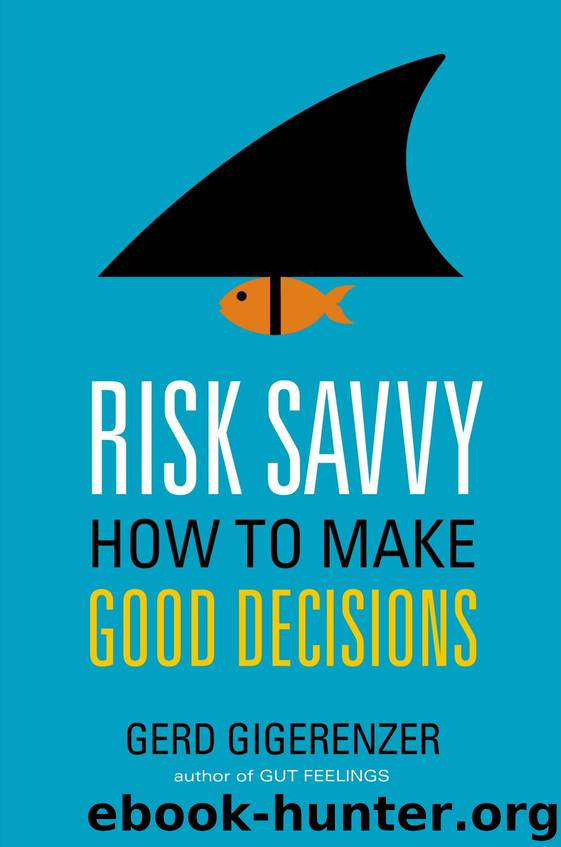Risk Savvy: How to Make Good Decisions by Gigerenzer Gerd

Author:Gigerenzer, Gerd [Gigerenzer, Gerd]
Language: eng
Format: epub, mobi
Publisher: Penguin Group US
Published: 2014-04-17T00:00:00+00:00
Prenatal Screening
Imagine you are thirty-five and pregnant. In many countries doctors advise all women thirty-five and over to attend screening for Down syndrome. Down syndrome, or trisomy 21, is the most frequent clinically important chromosome aberration at birth. Children born with this syndrome have forty-seven chromosomes instead of the usual forty-six, resulting in some impairment of mental ability and physical growth, and a particular set of facial characteristics. For women over thirty-five, the joy of being pregnant is tempered by anxiety about this or other birth defects. The risk of a child having Down syndrome, however, does not jump suddenly at thirty-five, but increases with the mother’s age. That is why this age limit makes little clinical sense. The question to ask is, how big is the risk at each age? For thirty-year-olds, the risk of delivering a baby with Down syndrome is about one in one thousand, varying across countries. If the mother is thirty-five, the risk increases to about three in one thousand, and for a forty-year-old, to about ten in one thousand.
For many pregnant women prenatal screening is an extremely stressful situation. Two tests are offered, a first-trimester blood test used for screening and, if the result is positive, a second invasive test such as amniocentesis or chorionic villus sampling (CVS). The first-trimester test includes a sonogram that can detect the excess skin on the necks of fetuses with Down syndrome and tests for serum markers. It can be done between the eleventh and fourteenth week.10 If the test is positive, women need to decide whether to undergo an invasive test such as amniocentesis, which leads to a miscarriage in about one in two hundred women. For a woman in her late thirties, this risk is about the same as the risk of having a baby with Down syndrome.
It’s therefore crucial to understand what a positive first-trimester test means. A British study found that some pregnant women and obstetricians believed it means that Down syndrome is absolutely certain, or close to certain.11 Once again the illusion of certainty is attached to a medical technology. But no test is absolutely certain. Each and every one makes errors. First, the sensitivity of a first-trimester screening is about 90 percent, meaning that the test detects 90 percent of babies with Down syndrome and misses the rest. Second, the false positive rate is about 5 percent, meaning that the test correctly identifies 95 percent of babies without Down syndrome and errs on the remaining 5 percent.12 Now we can find out what a positive test means for a forty-year-old woman:
About 1 percent of babies have Down syndrome.
If the baby has Down syndrome, there is a 90 percent chance that the test result will be positive.
If the baby is unaffected, there is still a 5 percent chance that the test result will be positive.
Download
Risk Savvy: How to Make Good Decisions by Gigerenzer Gerd.mobi
This site does not store any files on its server. We only index and link to content provided by other sites. Please contact the content providers to delete copyright contents if any and email us, we'll remove relevant links or contents immediately.
| Biomathematics | Differential Equations |
| Game Theory | Graph Theory |
| Linear Programming | Probability & Statistics |
| Statistics | Stochastic Modeling |
| Vector Analysis |
Weapons of Math Destruction by Cathy O'Neil(5037)
Factfulness: Ten Reasons We're Wrong About the World – and Why Things Are Better Than You Think by Hans Rosling(4021)
Factfulness_Ten Reasons We're Wrong About the World_and Why Things Are Better Than You Think by Hans Rosling(2754)
Descartes' Error by Antonio Damasio(2731)
A Mind For Numbers: How to Excel at Math and Science (Even If You Flunked Algebra) by Barbara Oakley(2691)
TCP IP by Todd Lammle(2639)
Applied Predictive Modeling by Max Kuhn & Kjell Johnson(2478)
Fooled by Randomness: The Hidden Role of Chance in Life and in the Markets by Nassim Nicholas Taleb(2413)
The Book of Numbers by Peter Bentley(2404)
The Tyranny of Metrics by Jerry Z. Muller(2401)
The Great Unknown by Marcus du Sautoy(2186)
Once Upon an Algorithm by Martin Erwig(2149)
Easy Algebra Step-by-Step by Sandra Luna McCune(2117)
Practical Guide To Principal Component Methods in R (Multivariate Analysis Book 2) by Alboukadel Kassambara(2092)
Lady Luck by Kristen Ashley(2073)
Police Exams Prep 2018-2019 by Kaplan Test Prep(2032)
Linear Time-Invariant Systems, Behaviors and Modules by Ulrich Oberst & Martin Scheicher & Ingrid Scheicher(1983)
All Things Reconsidered by Bill Thompson III(1960)
Secrets of Creation, Volume 1: The Mystery of the Prime Numbers by Watkins Matthew(1864)
